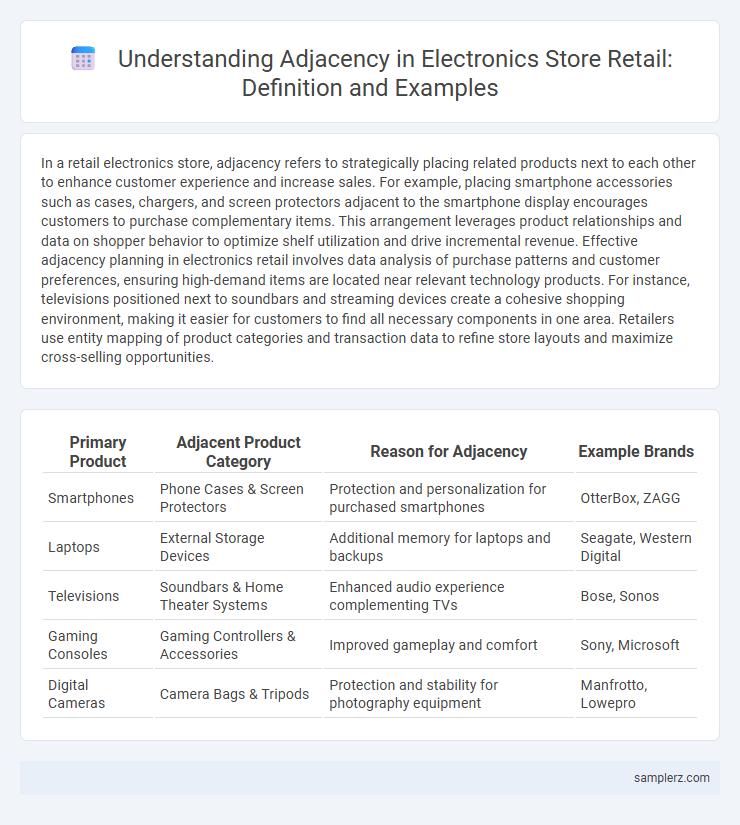In a retail electronics store, adjacency refers to strategically placing related products next to each other to enhance customer experience and increase sales. For example, placing smartphone accessories such as cases, chargers, and screen protectors adjacent to the smartphone display encourages customers to purchase complementary items. This arrangement leverages product relationships and data on shopper behavior to optimize shelf utilization and drive incremental revenue. Effective adjacency planning in electronics retail involves data analysis of purchase patterns and customer preferences, ensuring high-demand items are located near relevant technology products. For instance, televisions positioned next to soundbars and streaming devices create a cohesive shopping environment, making it easier for customers to find all necessary components in one area. Retailers use entity mapping of product categories and transaction data to refine store layouts and maximize cross-selling opportunities.
Table of Comparison
| Primary Product | Adjacent Product Category | Reason for Adjacency | Example Brands |
|---|---|---|---|
| Smartphones | Phone Cases & Screen Protectors | Protection and personalization for purchased smartphones | OtterBox, ZAGG |
| Laptops | External Storage Devices | Additional memory for laptops and backups | Seagate, Western Digital |
| Televisions | Soundbars & Home Theater Systems | Enhanced audio experience complementing TVs | Bose, Sonos |
| Gaming Consoles | Gaming Controllers & Accessories | Improved gameplay and comfort | Sony, Microsoft |
| Digital Cameras | Camera Bags & Tripods | Protection and stability for photography equipment | Manfrotto, Lowepro |
Understanding Adjacency in Electronics Retail
Understanding adjacency in electronics retail involves strategically placing complementary products, such as smartphones next to phone cases and chargers, to enhance cross-selling opportunities and simplify the shopping experience. Effective adjacency planning increases customer engagement, drives higher average transaction values, and improves overall store layout efficiency. Retailers who optimize adjacency leverage customer behavior insights and product relationships to maximize sales and inventory turnover.
The Role of Store Layout in Adjacency Strategies
Effective store layout in electronics retail strategically places complementary products such as smartphones adjacent to accessories like chargers and cases, enhancing customer convenience and increasing cross-selling opportunities. By aligning high-demand items like laptops near related peripherals such as external hard drives and wireless mice, stores create intuitive pathways that encourage extended browsing. This adjacency strategy optimizes space utilization while boosting overall sales through targeted product placement.
Examples of Adjacency: Smartphones and Accessories
Smartphones are strategically placed next to accessories such as chargers, cases, and screen protectors to encourage complementary purchases. This adjacency enhances shopper convenience by allowing customers to find all related items in one location, increasing average transaction value. Organizing products by compatibility and usage further boosts cross-selling opportunities and improves the overall shopping experience.
Enhancing Sales with Laptop and Printer Placement
Placing laptops adjacent to printers in an electronics store leverages shopper convenience and drives cross-category purchases by prompting customers to consider complementary accessories. This adjacency highlights product compatibility, encouraging customers to purchase both devices together, thereby increasing average transaction value. Strategic placement also improves customer experience by simplifying decision-making and demonstrating practical uses of the products side-by-side.
Bundling TVs with Streaming Devices: An Adjacency Approach
Bundling TVs with streaming devices leverages product adjacency by positioning complementary electronics together, enhancing the customer shopping experience and increasing average transaction value. Retailers strategically place smart TVs alongside popular streaming devices such as Roku, Amazon Fire Stick, or Apple TV to encourage cross-selling and upselling. This adjacency approach drives higher sales volume by simplifying purchase decisions and promoting bundled discounts that appeal to consumers seeking integrated entertainment solutions.
The Importance of Audio Equipment Near Televisions
Placing audio equipment near televisions in electronics stores enhances customer experience by allowing shoppers to easily compare sound quality alongside visual displays. Strategic adjacency increases cross-selling opportunities, boosting sales of soundbars, speakers, and home theater systems. This layout leverages consumer behavior, as customers tend to envision complete home entertainment setups when related products are displayed together.
Creating Tech Zones: Tablets Next to Smart Home Devices
Positioning tablets adjacent to smart home devices in an electronics store enhances the customer shopping experience by showcasing complementary technology. This adjacency encourages cross-selling opportunities, as shoppers exploring tablets can easily discover smart home hubs, sensors, and voice assistants. Creating tech zones with related products increases engagement and drives higher sales conversion rates in retail environments.
Impulse Buys: Placing Batteries and Cables near Checkout
Placing batteries and cables near the checkout area in an electronics store exemplifies strategic adjacency to boost impulse buys by leveraging customer convenience and product necessity. This placement taps into spontaneous purchasing behavior, increasing average transaction value while addressing last-minute needs for device usability. Retailers optimize shelf layout by situating essential accessories close to payment points, driving both product visibility and sales conversion.
Gaming Consoles and Game Titles: Strategic Placement
Strategic placement of gaming consoles next to popular game titles increases customer engagement and boosts sales in electronics stores. Positioning best-selling consoles like PlayStation 5 adjacent to top game releases such as "God of War" creates a seamless shopping experience that encourages impulse purchases. This adjacency leverages consumer behavior by highlighting compatible products, enhancing product visibility, and driving higher transaction values through targeted cross-selling.
Leveraging Adjacency for Cross-Selling in Electronics Stores
Leveraging adjacency in electronics stores involves strategically placing related products, such as pairing smartphones with compatible accessories like cases and chargers, to enhance cross-selling opportunities. Displaying gaming consoles next to popular video games and controllers increases customer convenience and encourages bundled purchases. This targeted product placement maximizes average transaction value by intuitively guiding shoppers to complementary items.

example of adjaceny in electronics store Infographic
 samplerz.com
samplerz.com